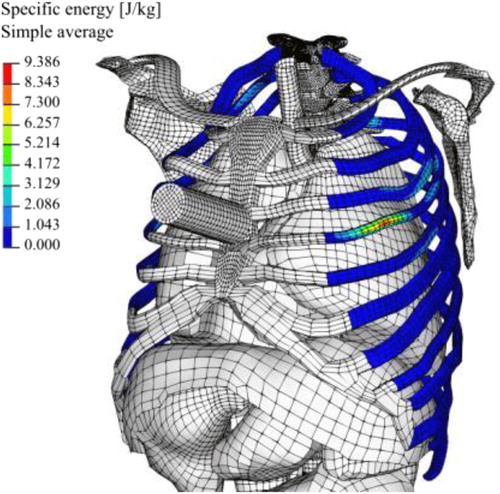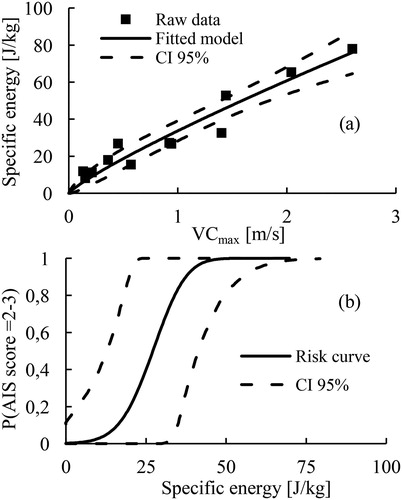1. Introduction
Since the last two decades, an intensive research has been carried out with the aim of enhancing the understanding of the human body response during non-penetrating ballistic impacts. Indeed, Less-Lethal Kinetic Energy projectiles (LLKE) can induce severe injuries while being used in operation theaters. A significant research through a clinical study on Post Mortem Human Subjects (PMHS) has provided an injury risk curve of rib fractures as a function of the viscous criterion VCmax (Bir and Viano Citation2004). This injury criterion remains valid only for mid-sternum impacts. To overcome this limitation, recent studies suggest the combined use of experimental and numerical analysis and highlight its benefits (Bracq et al. Citation2017; Bracq Citation2018; Bracq et al. Citation2019). Indeed, the Finite Element Method (FEM) leads to deeper analyses by the simulation of ballistic impacts on a numerical model of the human body. The human torso FE model HUByx has shown its ability to faithfully reproduce the human body response under impacts (Roth et al. Citation2013; Bodo et al. Citation2017). Thus, the goal of this paper is to exploit the clinical study available in the literature and simulate ballistic impacts on HUByx in order to compute a risk curve of skeletal injury independent of the impact location. It may benefit both law enforcement agencies and LLKE projectiles manufacturers.
2. Methods
On the one hand, raw data of a clinical study involving the impact of LLKE projectiles on the mid-sternum of PMHS are used to conduct a parametric survival analysis (Bir & Viano Citation2004). These data correspond to 16 datasets of continuous and binary values representing respectively VCmax values and dichotomous state of occurrence or non-occurrence of rib injury. Such a statistical analysis is justified by the fact that injury data (i.e. VCmax values) are censored. MATLAB subroutines (MathWorks) are employed to compute a risk curve fitting the data and its 95% confidence intervals (CI) considering a normal distribution. On the other hand, 12 impact conditions including 3 rigid projectiles of 37 and 40 mm in diameter are applied to HUByx’s mid-sternum using HyperMesh and the explicit FE code Radioss (Altair HyperWorks). These conditions cover a wide range of kinetic energy (from 10 to 240 J). It intends to identify a correlation between VCmax and numerical metrics related to the rib cortical bone. For each impact condition, the VCmax value is computed along with the maximum values of the von Mises strain and stress and the specific energy. displays the specific energy field of the ribs during an impact of a 37 mm caliber projectile on HUByx’s mid-sternum. A Pearson’s correlation matrix is computed for these numerical metrics using statistical subroutines available in MATLAB software.
3. Results and discussion
12 numerical datasets and the Pearson’s correlation matrix point out that the specific energy metric has the best correlation with VCmax. Hence, a power fitting function describes this relation with a R-squared coefficient of determination value of 0.922. presents the raw data, the fitted model and its 95% CI. Then, the survival analysis and the computed risk curve of rib fractures as a function of VCmax can be used. The power model is directly employed to determine a new risk curve based on a numerical metric: the specific energy of the rib cortical bone. The confidence intervals of each relation are processed in order to estimate the overall 95% CI of the new risk curve. shows the probability curve of AIS score of 2 or 3 based on rib fractures as a function of the specific energy of the cortical part of HUByx’s ribs. This new relation is independent of the impact location but depends on HUByx FE model and its material properties.
4. Conclusions
The ongoing use of LLKE projectiles encourages the authors to use literature studies and numerical tools in order to investigate non-penetrating ballistic impacts. On the first hand, the clinical study of Bir & Viano has led to a survival analysis and related risk curve of rib fractures as a function of VCmax. On the second hand, the FE model of the human torso HUByx has been employed to simulate the impact of rigid projectiles on HUByx’s mid-sternum. A risk curve of rib injury has been computed as a function of a rib cortical bone numerical metric independent of the impact location.
Hence, it can be used to take into account the impact location while predicting the risk of injury and designing rigid LLKE projectiles. New clinical and real world case studies would be needed reducing confidence intervals and giving more confidence in the overall survival analysis. Within the framework of ballistics, this original research may require the study of the influence of impact conditions on the HUByx’s response such as with deformable LLKE projectiles and behind armor dynamic deformation. In the field of applied biomechanics, geometrical and mechanical personalization of HUByx constitutes the next step ahead for a more realistic description of the population.
Acknowledgements
The authors gratefully acknowledge the support of these institutions.
Additional information
Funding
References
- Bir C, Viano DC. 2004. Design and injury assessment criteria for blunt ballistic impacts. J Trauma Inj Infect Crit Care. 57(6):1218–1224.
- Bodo M, Bracq A, Delille R, Marechal C, Roth S. 2017. Thorax injury criteria assessment through non-lethal impact using an enhanced biomechanical model. J Mech Med Biol. 17(6):1740027.
- Bracq A. 2018. Towards the prediction of thoracic injuries during blunt ballistic impacts through experimental and numerical approaches [Thesis]. Valenciennes, France: University of Valenciennes and Hainaut-Cambresis. Available from: https://tel.archives-ouvertes.fr/tel-01859920.
- Bracq A, Delille R, Maréchal C, Bourel B, Roth S, Mauzac O. 2019. Rib fractures prediction method for kinetic energy projectile impact: from blunt ballistic experiments on SEBS gel to impact modeling on a human torso FE model. Forensic Sci Int. 297:177–183.
- Bracq A, Maréchal C, Delille R, Bourel B, Roth S, Mauzac O. 2017. Methodology for ballistic blunt trauma assessment. Comput Methods Biomech Biomed Eng. 20(Suppl 1):31–32.
- Roth S, Torres F, Feuerstein P, Thoral-Pierre K. 2013. Anthropometric dependence of the response of a Thorax FE model under high speed loading: validation and real world accident replication. Comput Methods Programs Biomed. 110(2):160–170.


